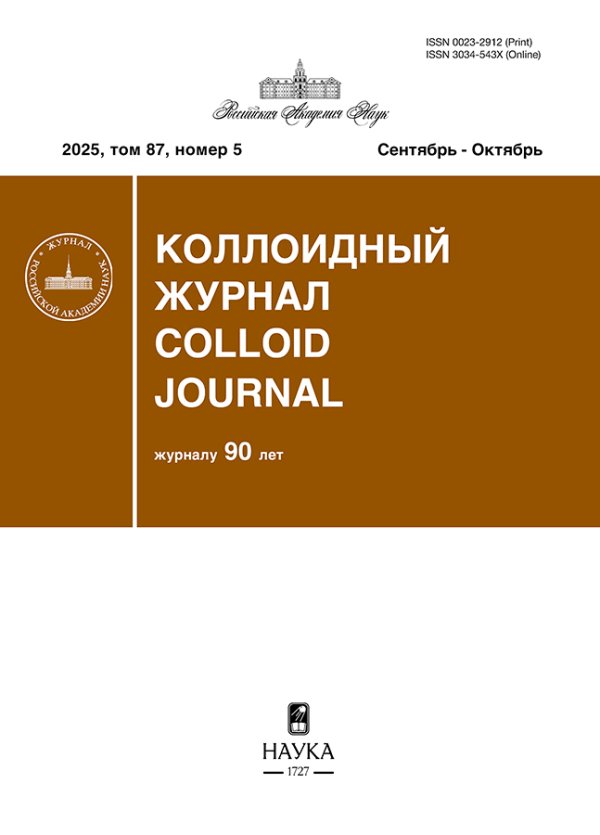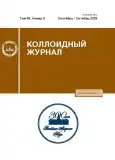Vol 85, No 5 (2023)
- Year: 2023
- Published: 01.09.2023
- Articles: 12
- URL: https://journals.rcsi.science/0023-2912/issue/view/7866
Full Issue
Articles
 551-555
551-555


Dynamic Properties of Pulmonary Lipid Monolayers on the Surfaces of Sodium Polystyrene Sulfonate and Polydiallyldimethylammonium Chloride Solutions
Abstract
Pulmonary surfactant, which is a complex mixture of lipids and proteins, plays a key role in the functional properties of the respiratory system. Lipids form complexes with proteins to maintain low values of surface tension at continuous compression/expansion deformations. However, interactions that lead to the complexation still remain to be unknown thus significantly hampering the development of synthetic analogs of the natural pulmonary surfactant. In this work, the methods of surface rheology and ellipsometry have been employed to study the dynamic properties of model phospholipid monolayers applied onto the surfaces of synthetic polyelectrolyte solutions. It has been shown, that electrostatic or hydrophobic interactions between lipids and macromolecules are insufficient for the efficient complexation and maintenance of low surface tension values.
 556-565
556-565


Stimuli-Responsive Drug Delivery Systems Based on Bilayer Lipid Vesicles: New Trends
Abstract
The development of new efficient methods for combating serious diseases, among which, oncological and infectious diseases hold a special place, remains to be an urgent challenge of biomedicine and biotechnology. Currently, the efforts of scientists are focused on the search for drug systems that provide high efficiency of treatment with minimal impacts on a human body. The development of this field has led to the creation of stimuli-responsive liposomes that can release an encapsulated drug under a specific stimulus, such as temperature, pH, electromagnetic field, light, etc. Being stimulated, lipid bilayer vesicles change their structure, size, surface charge, or phase state, thus leading to a controlled release of the drug in a specific place of the body, thereby resulting in a more accurate and efficient delivery. This review discusses the current trends in the development of liposome-based stimuli-responsive systems for the controlled delivery of biologically active substances.
 566-582
566-582


Impact of the Aging of Ultrasmall Gold Nanoparticles on their Interaction with Cholesteric DNA Microparticles
Abstract
The correlation between the time of preliminary storage of ultrasmall gold nanoparticles (GNPs) synthesized according to the Duff method and the structural aspects of their interaction with the particles of cholesteric liquid-crystalline dispersions (CLCDs) of DNA were studied. It has been established that the “age” of GNPs significantly affects the magnitude of their destructive action on the ordered organization of the DNA CLCD particles. The observed effect may be caused by both the gradual perfecting of the crystal lattice of the studied GNPs (i.e., their metallization) and the change in the chemistry of their surface over time.
 583-592
583-592


Etoposide-Loaded Colloidal Delivery Systems Based on Biodegradable Polymeric Carriers
Abstract
The review is focused on the etoposide delivery systems based on colloidal carriers, i.e., nanoparticles and micelles made of synthetic and natural polymers. Etoposide, a topoisomerase II inhibitor, occupies an important place in the chemotherapy of a number of tumors; however, its use is often limited due to severe side effects. The application of colloidal delivery systems makes it possible to change the pharmacokinetic parameters of etoposide and increase its accumulation in tumors leading to an increase in the antitumor effect. Of particular interest are stimuli-sensitive systems that respond to specific conditions in the tumor microenvironment, which can significantly increase the selectivity of the drug.
 593-618
593-618


Nanoemulsions and Solid Lipid Nanoparticles with Encapsulated Doxorubicin and Thymoquinone
Abstract
Nanoemulsions (NEs) and solid lipid nanoparticles (SLNs) are promising drug delivery systems. In this work, paraffin oil NEs and stearic acid SLNs stabilized with Tween 60 and Span 60 have been studied. NEs with an average droplet diameter of ~50 nm and suspensions of SLNs with an average size of ~30 nm are stable to aggregation for more than 90 days. The rates of penetration of lipid particles into cancer cells (C6 and MCF-7) depend on their sizes. After incubation for 1 h, lipid nanoparticles ~50 nm in size penetrate into cells, are distributed in their internal space, and concentrate in the nuclei. The cytotoxicity of doxorubicin- or thymoquinone-loaded NEs and SLNs against MCF-7 and HTC 116 cell lines is higher than the cytotoxicity of the individual substances. Wherein, unloaded NEs and SLNs show low cytotoxicity. The obtained results demonstrate that paraffin oil NEs and stearic acid SLNs are promising to be used as carriers of both lipophilic and amphiphilic drugs, including doxorubicin and thymoquinone. The accumulation of lipid nanoparticles with sizes smaller than 100 nm in cell nuclei is an advantage of such systems for the delivery of anticancer drugs, because this leads to DNA replication suppression followed by cell apoptosis.
 619-628
619-628


Lecithin Microemulsions as Drug Carriers
Abstract
The paper describes examples of microemulsions based on a well-known biocompatible surfactant, lecithin, and the possibilities of their use as drug carriers. The main problem encountered when developing lecithin microemulsions is the search for suitable cosurfactants. Molecules with short alkyl chains (4–5 C atoms) and relatively large polar “head,” such as short-chain aliphatic alcohols, acids, and amines are most suitable as cosurfactants for the preparation of lecithin microemulsions. Therewith, high concentrations of the cosurfactants (the cosurfactant : lecithin weight ratio usually is 1 : 1) are necessary. Most often, ethanol, n-propanol, or n-butanol are used as cosurfactants for the preparation of lecithin microemulsions in various natural and synthetic oils. To replace toxic alcohols with less toxic components, other well-known surfactants may be added to lecithin microemulsions. They are, e.g., Brij 96V (poly(ethylene glycol) oleate), Tween 80 (polyoxyethylene-20-sorbitan monooleate), Tween 20 (polyoxyethylene-20-sorbitan monolaurate). Triton X-100 (tert-octylphenyl ether of poly(ethylene glycol)) or oleic acid. Composites based on lecithin microemulsions have been described as means for local anesthesia and delivery of vitamins, as well as agents with anti-inflammatory, antifungal, anticancer, and wound healing effects. The considered examples show the promise of the study and development of lecithin microemulsions as drug carriers.
 629-640
629-640


Effect of Biological Contamination of Copper Surfaces with Extreme Wettability on Their Antibacterial Properties
Abstract
Bacterial health care-associated infections (HCAI) are one of the acute problems of modern healthcare. One of the promising directions for solving this problem is the development of materials that either have a bactericidal effect against HCAI pathogens or prevent the transmission of bacteria deposited on their surface by patients and staff contacts with such surfaces. In this work, the antibacterial effectiveness of copper contact surfaces with different wettability was investigated. Particular attention was paid to studying the effect on this efficacy of surface contamination by both human contact sweat and bacterial life-supporting substances, using a peptone solution as an example. Due to the high cost of copper, the possibility of replacing bulk copper material with less expensive sprayed copper-coated materials was also investigated. The test results showed that the bactericidal efficacy against Staphylococcus aureus strain of both control copper and superhydrophilic copper samples, as well as of sputtered copper films, is close to 100% and almost unchanged after contamination with peptone solution or sweat excretions. Superhydrophobic copper surfaces have less bactericidal efficacy, but due to the non-wettability effect and low cell adhesion to such surfaces, they remain uncontaminated longer and thus also promote reducing the transmission of infections through the touch surfaces made of them.
 641-654
641-654


Nanoparticle Concentration as an Important Parameter for Characterization of Dispersion and Its Applications in Biomedicine
Abstract
Currently, there are problems to standardize methods for determining the concentration of nanoparticles and creation of etalon materials for calibrating measured concentrations. Accurate determination of nanoparticle concentration is necessary to assess the maximum dose of administered nanotherapeutics for diagnostics and therapy in vivo, to determine the order of reaction in enzymatic nanoreactors. In addition, this parameter determines biological effects, such as the formation of a protein corona on the outer surface of nanoparticles that precedes nanoparticles’ absorption and internalization in cells. This review discusses the most common methods for determining the concentration of nanoparticles based on direct visualization, using microscopy, light absorption or light scattering, direct counting of nanoparticles, and gravimetry. Results may differ from one method to the other. Thus, the use of a combination of several methods provides more reliable results. The advantages, disadvantages and ways to improve accuracy of results are also presented.
 655-667
655-667


Enzyme-Like Activity of Cerium Dioxide Colloidal Solutions Stabilized with L-Malic Acid
Abstract
For the first time, stable aqueous colloidal solutions of cerium dioxide stabilized with L-malic acid have been obtained at ligand : CeO2 molar ratios of 0.2, 0.5, 1.0, and 2.0. Using dynamic light scattering, it has been shown that CeO2 sols are characterized by a narrow monomodal size distribution of aggregates, and the sols remain to be aggregatively stable in a Tris-HCl buffer solution. According to the chemiluminescence analysis of the enzyme-like activity of cerium dioxide sols with respect to hydrogen peroxide, the surface modification of the cerium dioxide particles with malic acid increases the enzyme-like activity of СеО2 up to 4.5 times.
 668-681
668-681


Biocompatible Hydrogels Based on Biodegradable Polyesters and Their Copolymers
Abstract
Poly(ethylene glycol)-based hydrogels have long proved to be promising materials for various biomedical technologies. This review considers systems based on the most common and studied copolymers of poly(ethylene glycol) and biodegradable polyesters of lactide and glycolide. Traditional and modern approaches to the synthesis of the copolymers and the production of hydrogels have been considered, the studies of the structure and properties of the materials have been analyzed, and the main directions of the application of these products in practice have been described.
 682-704
682-704


Lipid Nanoparticles for Lutein Encapsulation and Delivery
Abstract
Recently, lipid nanoparticles have been intensively studied as carriers of lipophilic drugs. In this work, we have studied the stability of nanoemulsions with paraffin oil, solid lipid nanoparticles with stearic acid, and nanostructured lipid particles with paraffin oil and stearic acid in a mass ratio of 1 : 1. The obtained results have shown that all studied lipid systems stabilized with nonionic surfactants Tween 60 and Span 60 were stable to aggregation and subsequent sedimentation for more than 30 days. The incorporation of lutein into the lipid particles has almost no effect on their stability, while the size of solid lipid nanoparticles and nanostructured lipid nanoparticles decreases from 28–30 to 15–17 nm. The bioavailability of lutein loaded in lipid nanoparticles is evaluated from their effect on the restoration of blood flow velocity by simulating hemic hypoxia. Almost immediately after the application of lipid nanoparticles, the blood flow velocity ceases to decrease, and a tendency to its restoration is observed in 5–10 min. This shows that lipid nanoparticles with paraffin oil and stearic acid are promising candidates for the delivery of lipophilic drugs.
 705-714
705-714












